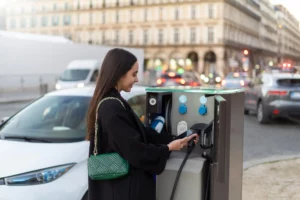
Home / EV Charging News / Can You Safely Charge an Electric Car in the Rain?
As electric vehicles (EVs) become more popular, questions about their use in various weather conditions arise. One of the most common concerns among new and prospective EV owners is whether it’s safe to charge an electric car in the rain. Given that electricity and water are usually a dangerous combination, it’s understandable why some people might worry about plugging in their EV during a downpour. In this article, we’ll explore the safety aspects of charging an electric car in the rain, debunk some common myths, and provide practical tips to ensure a safe charging experience in wet conditions.
The design and engineering of electric vehicles and their charging systems take safety seriously. EVs are built with multiple layers of protection to ensure that charging is safe, even in adverse weather conditions.
Electric vehicle chargers and charging ports are designed to be weather-resistant. This means that they are thoroughly insulated and sealed to prevent water ingress. Charging equipment, including the cables, connectors, and the vehicle’s charging port, is built to withstand exposure to rain and moisture. In fact, the charging connectors and ports are designed to meet stringent safety standards, including IP (Ingress Protection) ratings that indicate their resistance to dust and water.
For instance, most EV charging connectors are rated at IP66 or higher, meaning they are protected against powerful water jets from any direction. This level of protection ensures that the connectors remain safe to use, even in heavy rain.
Electric vehicles and charging stations are equipped with advanced safety features that automatically detect and prevent dangerous conditions. For example, if a charging port detects water or moisture, it can shut down the charging process immediately to prevent any risk of electric shock. Additionally, the charging system includes ground fault circuit interrupters (GFCIs), which cut off the electricity supply if a fault is detected, further enhancing safety during wet weather conditions.
These built-in safety measures mean that charging your EV in the rain is generally safe, as the system is designed to protect both the vehicle and the user from any potential hazards.
Despite the safety measures in place, there are still many myths surrounding the idea of charging an electric car in the rain. Let’s address some of the most common misconceptions.
While charging your electric vehicle in the rain is generally safe, following a few practical tips can ensure an even safer experience.
Charging an electric car in the rain is safe, thanks to the robust design and safety features built into modern EVs and charging equipment. The waterproofing, insulation, and automatic safety shutoffs ensure that both the vehicle and user are protected, even in wet conditions. While myths about the dangers of charging in the rain persist, understanding the technology and following a few simple precautions can help dispel these concerns. So, the next time you need to charge your electric vehicle during a rainstorm, you can do so with confidence, knowing that your EV and its charging system are designed to handle it safely.
